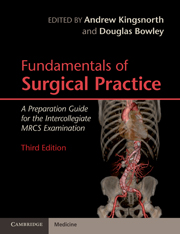Book contents
- Frontmatter
- Contents
- List of contributors
- Preface
- Section 1 Basic Sciences Relevant to Surgical Practice
- 1 Pharmacology and the safe prescribing of drugs
- 2 Fundamentals of general pathology
- 3 Fundamentals of surgical microbiology
- 4 Fundamentals of radiology
- Section 2 Basic Surgical Skills
- Section 3 The Assessment and Management of the Surgical Patient
- Section 4 Perioperative Care of the Surgical Patient
- Section 5 Common Surgical Conditions
- Index
- References
4 - Fundamentals of radiology
Published online by Cambridge University Press: 03 May 2011
- Frontmatter
- Contents
- List of contributors
- Preface
- Section 1 Basic Sciences Relevant to Surgical Practice
- 1 Pharmacology and the safe prescribing of drugs
- 2 Fundamentals of general pathology
- 3 Fundamentals of surgical microbiology
- 4 Fundamentals of radiology
- Section 2 Basic Surgical Skills
- Section 3 The Assessment and Management of the Surgical Patient
- Section 4 Perioperative Care of the Surgical Patient
- Section 5 Common Surgical Conditions
- Index
- References
Summary
Key learning objectives
Describe basic principles of plain X-ray, fluoroscopy, computed tomography (CT), magnetic resonance imaging (MRI), nuclear medicine including PET and ultrasound (USS) as used in diagnostic imaging.
Describe the basic principles of image guided biopsy and interventional radiology techniques.
Highlight the potential risks and hazards related to diagnostic imaging techniques.
Plain film radiography
Wilhelm Conrad Röntgen first discovered X-rays in November 1895, with his work earning the 1901 Nobel Prize in Physics. Initial photographic images, using the newly discovered rays, quickly demonstrated potential for medical application, especially in the localization of foreign bodies and diagnosis of fractures. Plain radiographs are still regularly used in initial assessment of patients, especially after trauma and for the acute abdomen.
In order to obtain a plain radiograph, the area of interest is positioned between a beam of electromagnetic radiation and a radiosensitive detector. The radiation is produced by the interaction between high-energy electrons produced by a heated tungsten cathode with a tungsten anode. The energy of the photons in this radiation beam lies within the X-ray spectrum of energy. The patient's tissue interacts with the photons, either absorbing or scattering (deflecting) them. The degree and type of interaction depends on the thickness, density and atomic density of the matter as well as the energy of photons in the beam with the net effect of attenuating the beam, i.e. reducing beam intensity.
- Type
- Chapter
- Information
- Fundamentals of Surgical PracticeA Preparation Guide for the Intercollegiate MRCS Examination, pp. 54 - 70Publisher: Cambridge University PressPrint publication year: 2011

